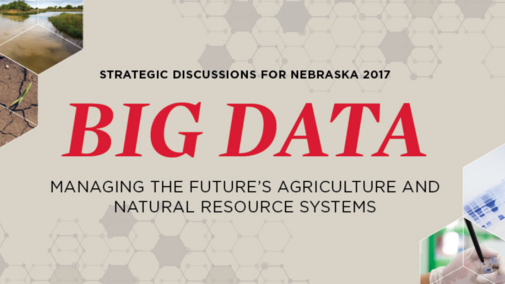Today's farmers have access to gigabytes of data from crop and climate sensors, equipment meters, and public sources of GPS, soil type and other data. Bits of data, layers of data, so much data it can be hard to interpret and use to make relevant farm management decisions. That's why faculty in the Institute of Agriculture and Natural Resources are working with farmers to better understand and use this data to aid in management decisions.
Strategic Discussions for Nebraska, a publication of the Institute of Agriculture and Natural Resources, takes a closer look at several programs through stories written by students majoring in Agricultural and Environmental Sciences Communication. The students interviewed University of Nebraska–Lincoln scientists.
While the publication covers an array of topics, those most related to crop production are noted below. Find additional SDN articles at https://sdn.unl.edu/2017-big-data.
To request a free printed copy of "Strategic Discussions for Nebraska: Big Data — Managing the Future's Agriculture and Natural Resource Systems," contact Mary Garbacz, SDN Editor and Coordinator, at mgarbacz2@unl.edu or 402-472-7119.
To Build, Enhance, Progress
An interview with IANR Vice Chancellor Michael Boehm by Lauren Stohlmani
The Morrill Act may have founded the land-grant university system in 1862, but Michael Boehm finds it to be thriving at the University of Nebraska–Lincoln in 2017. Boehm became University of Nebraska Vice President for Agriculture and Natural Resources and Harlan Vice Chancellor of the university’s Institute of Agriculture and Natural Resources on January 1, 2017. Read the full interview with IANR Vice Chancellor Michael Boehm.
Why Focus on Big Data?
An interview with IANR Senior Associate Vice Chancellor Ron Yoder by Shelby Andersen
Scientists have the ability to collect hundreds of data points in a single second with information from just one simple sensor. Multiply that times all kinds of sensors and all kinds of science and it’s easier to understand the challenges of what’s often called “big data.” Read the full interview with Ron Yoder
Drones: Piloting a Different Way of Seeing Agriculture
An interview with Extension Soil Fertility Specialist Richard Ferguson by Bryce Doeschot
Advancing the use of remote sensors to improve efficiency for moisture, nutrients, and pest control. Flying over a field at 60 miles per hour is a device collecting data about the way a crop reflects light. The device sends the data to cloud-based software that gives a farmer real-time information about the crop. With that information, a farmer is able to make management decisions such as how much water or nitrogen to apply to the crop. Read the full interview with Richard Ferguson.
Precision Agriculture: Engineering Solutions for the 21st Century
An interview with Extension Precision Ag Engineer Joe Luck by Cassandra Huck
Meeting the food and fiber needs of a growing world population requires changes in traditional production techniques and attention to efficiency and sustainability. Precision agriculture is a leader in this transformation, and Joe Luck is a leader in precision agriculture. Read the full interview with Joe Luck.
Big Data and Wheat Stem Sawfly
An interview with Extension Entomologist Jeff Bradshaw by Aliesha Dethlefs
The broad impact of Jeff Bradshaw’s research is to improve the lives of agricultural producers in western Nebraska, improving the human condition along the way. Bradshaw is an associate professor of entomology and Extension entomologist at the University of Nebraska–Lincoln Panhandle Research and Extension Center in Scottsbluff, where he conducts research on the wheat stem sawfly. Read the full Interview with Jeff Bradshaw.
Nebraska On-Farm Research Network
An interview with Extension Educator Laura Thompson by By Diana Marcum
Helping farmers to improve production practices and increase profitability are goals of the On-Farm Research Network, a part of Nebraska Extension at the University of Nebraska–Lincoln. An early network was established in 1989, with 20 producers from Saunders County who were interested in improving their techniques and profitability. In 2012, the Nebraska On-Farm Research Network was formalized through Nebraska Extension, officially bringing together all the on-farm research programs across the state. Read the full interview with Laura Thompson.

